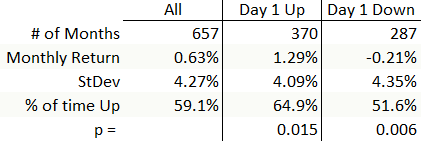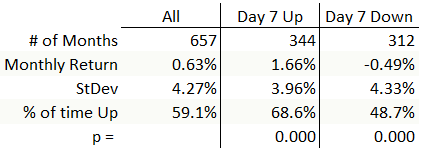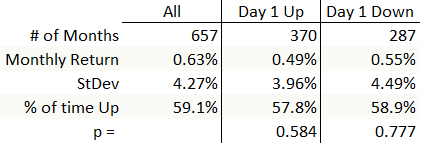Bad statistics lead to bad decisions: the first day of the month effect
It is easy to calculate statistics, and it seems like, more and more, we are bombarded with market statistics from every side. The problem is that many of those statistics are false or misleading and making market decisions based on those statistics can be hazardous to your financial health. Truly, having no information would be better than having false or bad information so it is up to all of us, producers and consumers of statistics alike, to be on guard for errors and bad stats.
There have been a lot of statistics floating around about what happens after a weak first day of the month or quarter, claiming that a down first day gives a downward bias to the entire quarter (or month). First of all, let's look at the stats that are floating around. Using the S&P 500 cash index back to 1961, if the first day of the month is up (which happened 370 months), the entire month was up 64.9% of the time, for an average monthly gain of 1.29%. If that first day of the month was down (which only happened 287 times), the month only closed positive 51.2% of the time, and the average return for all of those months was -0.21%. Here are the results presented in table format:

These are strong numbers that seem to show a tremendous edge in the marketplace, but let's dig deeper. First, ask yourself if they make sense. I would argue, right out of the gate, that they do not, but perhaps we could make a case for some kind of monthly momentum--maybe managers tend to put money to work at the beginning of the month and that has some persistence through the entire month. Maybe there is another reasonable explanation. It is, at least, possible to make an argument, so the results are not completely illogical.
However, something interesting happens if we examine day two of the month; we find the same effect. No, not for day 1 and day 2 being a cumulative decline for the month (though we can do that test, too), but simply if day 2 is up, the month tends to be up. Also day 3... and day 4.... In fact, no matter which day of the month we examine, we find if that day is up, the month tends to be up! If it is down, the entire month tends to be down. Just for fun, here are stats for trading day 7 of the month:

So, now we have a problem. How do we feel about the argument of monthly momentum or managers putting money to work on, say, day 17 of the month? Obviously, this is now completely illogical, so we have to look elsewhere for an explanation, and it makes sense to turn our attention to the way we ran the test. Maybe there is a problem with the methodology? As an aside, I once knew a trader who had a system that was based on a similar idea. He had done enough research to know that his system "worked", statistically speaking, no matter which day or days of the month (or quarter, or week, or even which hour of the intraday period) used as a trigger. Over the course of about a decade he had traded the system live, and had lost a significant amount of money--high seven figures on this particular system.You might ask why he kept going back to it, but the reason was statistics. Every way (except the right way) he looked at the system and twisted the inputs, the results were astoundingly strong, yet the system failed to produce in actual trading.
This is not an academic exercise; statistical mistakes are not abstract. For traders, statistics are life and death; statistics are the tool through which we understand how the market moves. Bad statistics lead to bad decisions, and bad decisions cost money.
I'll follow up in a few days with a post explaining the methodological error here, but first, let me leave you with the "correct" statistics for the "first day of the month" effect:

Based on these test results we can say we see no effect--that, whether the first day of the month (or, in fact, any particular day) is up or down has no significant effect on the overall direction of the month. There is no tradable edge here, and, unless our test has missed something ((always a possibility--stay humble!)) there is simply nothing here worth thinking about.
There is a simple solution to mistakes like this, and I'll share it with you in my next blog post. For now, spend some time thinking about where the error might be in the method, why it matters, and why it might be hard to catch. Here's a hint: what is a monthly return?



